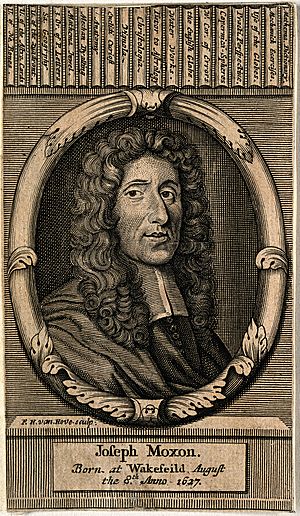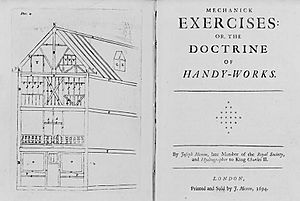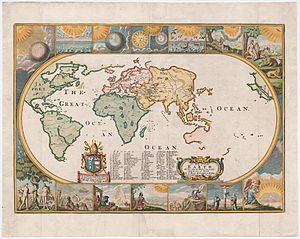Joseph Moxon facts for kids
Quick facts for kids
Joseph Moxon
|
|
|---|---|

Engraving of Joseph Moxon, 1692, by Frederick Hendrik van Hove.
|
|
| Born | 8 August 1627 |
| Died | February 1691 (aged 63) |
| Nationality | English |
Joseph Moxon (born August 8, 1627 – died February 1691) was an amazing English printer and mapmaker. He was even the official mapmaker for King Charles II.
Moxon was known for many things. He created the first English dictionary just for math terms. He also wrote the first detailed guide on how to print books. Plus, he made the first "how-to" books in English for different skilled jobs. In 1678, he became the first tradesman to join the Royal Society, a very important group for scientists.
Contents
Early Life and Learning
Joseph Moxon was born in Wakefield, Yorkshire, England. When he was about 9 to 11 years old, he went with his father, James Moxon, to places like Delft and Rotterdam in the Netherlands. His father was there printing English Bibles. This is where young Joseph first learned the basics of printing.
A Printer and Mapmaker
After the First English Civil War, Joseph and his older brother, James, came back to London. They started their own printing business. They mostly printed books about Puritan beliefs. However, they also made a special book in 1647 called A Book of Drawing, Limning, Washing or Colouring of Mapps and Prints for a map seller named Thomas Jenner.
In 1652, Moxon traveled to Amsterdam. He ordered special plates to print globes. By the end of that year, he was selling large globes of the Earth and the stars. This was a new part of his business. He became an expert in printing maps and charts. He also made globes and other math tools out of paper.
Mechanick Exercises
One of Moxon's most famous works was Mechanick Exercises. He published it in parts between 1677 and 1684. This work ended up being two big books.
The first book taught people how to work with metal and wood. It also showed how to lay bricks and build sundials. The second book, published later, was a very detailed guide for printers. It explained everything from making the metal type letters to setting up the pages and using the printing press. This book gives us a lot of information about how printing was done back then.
Official Mapmaker for the King
In January 1662, Joseph Moxon was given an important job. He became the official hydrographer (mapmaker) for the King, Charles II. This was special because Moxon had a Puritan background, and the King was not Puritan.
Moxon's shop was first on Ludgate Hill. Later, in 1683, it moved to Fleet Ditch. His shop was always known by its sign, "Atlas," which was a giant holding up the world.
Arctic Theories
Moxon had some interesting ideas about the Arctic. He thought that the Arctic was actually free of ice. He believed it was warmed by 24 hours of sunlight during the summer.
He also thought that Arctic ice only formed near land. So, if a ship sailed far enough north, away from any land, it would find clear, ice-free waters. These ideas made him believe that the Northwest Passage could be found by sailing close to the North Pole. Later, other explorers like Captain Cook were influenced by Moxon's ideas when they searched for the Northwest Passage.
Later Life
Joseph Moxon passed away in 1691. His son, James Moxon, took over his business and continued to make maps, engravings, and instruments.
Works
- A Tutor to Astronomy & Geography. Or, The Use of the Copernican Spheres. London (1665)
- Mechanick Exercises or the Doctrine of Handy-Works, 2 volumes. London (1677-1683)
- A collection of some attempts made to the North-East, and North-West, for the finding a passage to Japan, China, &c. London (1676)
- With Thomas Tuttell. Mathematicks made easie, or, A mathematical dictionary explaining the terms of art and difficult phrases used in arithmetick, geometry, astronomy, astrology, and other mathematical sciences. London (1700)
- Mechanick Exercises or the Doctrine of Handy-Works. London (1703 edition)



